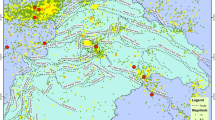Abstract
To minimize catastrophic impacts of earthquakes, many researchers have directed their efforts to developing novel computational techniques and models that forecast natural disasters based upon earthquake catalogues, anomalies in the ionosphere, and radon time series databases, etc. In this article, we propose a methodology that categorizes the soil radon gas (SRG) concentration into seismically active and non-active time series by taking the advantage of a stacking ensemble approach and utilizing an automatic anomaly indication function as a post-processing technique. The main idea behind the proposed methodology is of two layers. The first layer uses a stacking ensemble-based approach that incorporates three learners, i.e. a generalized linear model, linear regression and K-nearest neighbors, to train on seismically active and inactive periods to predict SRG concentration. These predictions are then combined with the labeled anomaly data to train a meta-learner, i.e., support vector machine with a radial kernel, that categorizes the series into active and non-active radon time series data. In the second layer, these classifications are then passed to an automatic anomaly indication function that further labels the time series in a group of readings where the level of received indications is greater than or equal to the indication factor. Radon time series (RTS) data has been recorded over a fault line present in Muzaffarabad, a city in the Pakistan territory of Kashmir, ranging from 1 March 2017 to 28 February 2018. Four seismic events occurred during the study period. The conclusion of the study reveals that the proposed methodology accurately locates the anomaly in the RTS data at different window sizes, i.e. with respect to individual days. The evaluation is based purely on the classification after processing of RTS data by both layers of the proposed methodology.














Similar content being viewed by others
Change history
10 June 2021
A Correction to this paper has been published: https://doi.org/10.1007/s00024-021-02764-5
References
Asada, B. (1982). Earthquake prediction techniques: Their application in Japan. University of Tokyo Press.
Asim, K. M., Idris, A., Iqbal, T., & Martinez-Alvarez, F. (2018). Earthquake prediction model using support vector regressor and hybrid neural networks. PLoS ONE, 13(7), e199004
Asim, K. M., Moustafa, S. S., Niaz, I. A., Elawadi, E. A., Iqbal, T., & Martínez-Álvarez, F. (2020). Seismicity analysis and machine learning models for short-term low magnitude seismic activity predictions in Cyprus. Soil Dynamics and Earthquake Engineering, 130, 105932
Bagnall, A., Lines, J., Hills, J., & Bostrom, A. (2015). Time-series classification with COTE: The collective of transformation-based ensembles. IEEE Transactions on Knowledge and Data Engineering, 27(9), 2522–2535
Barkat, A., Ali, A., Hayat, U., Crowley, Q. G., Rehman, K., Siddique, N., et al. (2018). Time series analysis of soil radon in Northern Pakistan: Implications for earthquake forecasting. Applied Geochemistry, 97, 197–208
Bradley, A. P. (1997). The use of the area under the ROC curve in the evaluation of machine learning algorithms. Pattern Recognition, 30(7), 1145–1159
Breiman, L. (1996). Stacked regressions. Machine Learning, 24(1), 49–64
Calais, E., & Minster, J. B. (1995). GPS detection of ionospheric perturbations following the January 17, 1994, Northridge earthquake. Geophysical Research Letters, 22(9), 1045–1048
Cigolini, C., Poggi, P., Ripepe, M., Laiolo, M., Ciamberlini, C., Delle Donne, D., et al. (2009). Radon surveys and real-time monitoring at Stromboli volcano: Influence of soil temperature, atmospheric pressure and tidal forces on 222Rn degassing. Journal of Volcanology and Geothermal Research, 184(3–4), 381–388
Clarke, B. (2003). Comparing Bayes model averaging and stacking when model approximation error cannot be ignored. Journal of Machine Learning Research, 4(1), 683–712
Davidenko, D., & Pulinets, S. (2019). Deterministic variability of the ionosphere on the eve of strong (M ≥ 6) earthquakes in the regions of Greece and Italy according to long-term measurements data. Geomagnetism and Aeronomy, 59(4), 493–508
Dietterich, T. G. (1997). Machine-learning research. AI Magazine, 18(4), 97–97
Dietterich, T. G. (2000). Ensemble methods in machine learning. In International workshop on multiple classifier systems, 2000 (pp. 1–15). Springer.
Džeroski, S., & Ženko, B. (2004). Is combining classifiers with stacking better than selecting the best one? Machine Learning, 54(3), 255–273
Finkelstein, M., Brenner, S., Eppelbaum, L., & Ne’Eman, E. (1998). Identification of anomalous radon concentrations due to geodynamic processes by elimination of Rn variations caused by other factors. Geophysical Journal International, 133(2), 407–412
Gams, M., Bohanec, M., & Cestnik, B. (1994). A schema for using multiple knowledge. In Proceedings of the workshop on Computational learning theory and natural learning systems (vol. 2): Intersections between theory and experiment: Intersections between theory and experiment, 1994 (pp. 157–170).
Hanley, J. A., & McNeil, B. J. (1982). The meaning and use of the area under a receiver operating characteristic (ROC) curve. Radiology, 143(1), 29–36
Hansen, L. K., & Salamon, P. (1990). Neural network ensembles. IEEE Transactions on Pattern Analysis and Machine Intelligence, 12(10), 993–1001
Igarashi, G., Saeki, S., Takahata, N., Sumikawa, K., Tasaka, S., Sasaki, Y., et al. (1995). Ground-water radon anomaly before the Kobe earthquake in Japan. Science, 269(5220), 60–61
İnan, S., Kop, A., Çetin, H., Kulak, F., Pabuçcu, Z., Seyis, C., et al. (2012). Seasonal variations in soil radon emanation: Long-term continuous monitoring in light of seismicity. Natural Hazards, 62(2), 575–591
Jaishi, H. P., Singh, S., Tiwari, R. P., & Tiwari, R. C. (2014). Analysis of soil radon data in earthquake precursory studies. Annals of Geophysics, 57(5), 0544
Jin, L.-P., & Dong, J. (2016). Ensemble deep learning for biomedical time series classification. Computational Intelligence and Neuroscience, 2016, 1
Klusman, R. W., & Webster, J. D. (1981). Preliminary analysis of meteorological and seasonal influences on crustal gas emission relevant to earthquake prediction. Bulletin of the Seismological Society of America, 71(1), 211–222
Kraner, H. W. (1964). Measurements of the effects of atmospheric variables of 222Rn flux and soil-gas concentration. The Natural Radiation Environment.
Li, W., Hu, W., & Abubakar, A. (2020). Machine learning and data analytics for geoscience applications—Introduction. Geophysics, 85(4), 1–4
Liu, J. Y., Chuo, Y., Shan, S., Tsai, Y., Chen, Y., Pulinets, S., et al. (2004). Pre-earthquake ionospheric anomalies registered by continuous GPS TEC measurements. Annals of Geophysics, 22, 1585
Mendes-Moreira, J., Soares, C., Jorge, A. M., & Sousa, J. F. D. (2012). Ensemble approaches for regression: A survey. ACM Computing Surveys (CSUR), 45(1), 1–40
Mollo, S., Tuccimei, P., Heap, M., Vinciguerra, S., Soligo, M., & Castelluccio, M., et al. (2011). Increase in radon emission due to rock failure: An experimental study. Geophysical Research Letters, 38(14).
Naeini, E. Z., & Prindle, K. (2018). Machine learning and learning from machines. The Leading Edge, 37(12), 886–893
Perrone, M. P., & Cooper, L. N. (1992). When networks disagree: Ensemble methods for hybrid neural networks. Brown Univ Providence Ri Inst For Brain and Neural Systems.
Planinic, J., Radolic, V., & Culo, D. (2000). Searching for an earthquake precursor: Temporal variations of radon in soil and water. Fizika B Zagreb, 9(2), 75–82
Qiu, X., Zhang, L., Ren, Y., Suganthan, P. N., & Amaratunga, G. (2017). Ensemble deep learning for regression and time series forecasting. In 2014 IEEE symposium on computational intelligence in ensemble learning (CIEL), 2014 (pp. 1–6). IEEE.
Rafique, M., Tareen, A. D. K., Mir, A. A., Nadeem, M. S. A., Asim, K. M., & Kearfott, K. J. (2020). Delegated regressor, a robust approach for automated anomaly detection in the soil radon time series data. Scientific Reports, 10(1), 1–11
Richon, P., Sabroux, J. C., Halbwachs, M., Vandemeulebrouck, J., Poussielgue, N., & Tabbagh, J., et al. (2003). Radon anomaly in the soil of Taal volcano, the Philippines: A likely precursor of the M 7.1 Mindoro earthquake (1994). Geophysical Research Letters, 30(9).
Seewald, A. K. (2002). How to make stacking better and faster while also taking care of an unknown weakness. In Proceedings of the nineteenth international conference on machine learning, 2002 (pp. 554–561).
Singh, M., Ramola, R., Singh, S., & Virk, H. (1988). The influence of meteorological parameters on soil gas radon. Journal of Association of Exploration Geophysicists, 9, 85–90
Smyth, P., & Wolpert, D. H. (1998). An evaluation of linearly combining density estimators via stacking: Information and computer science. University of California.
Tareen, A. D. K., Asim, K. M., Kearfott, K. J., Rafique, M., Nadeem, M. S. A., Iqbal, T., et al. (2019). Automated anomalous behaviour detection in soil radon gas prior to earthquakes using computational intelligence techniques. Journal of Environmental Radioactivity, 203, 48–54
Tareen, A. D. K., Nadeem, M. S. A., Kearfott, K. J., Abbas, K., Khawaja, M. A., & Rafique, M. (2019). Descriptive analysis and earthquake prediction using boxplot interpretation of soil radon time series data. Applied Radiation and Isotopes, 154, 108861
Tasnim, S., Rahman, A., Oo, A. M. T., & Haque, M. E. (2017). Wind power prediction using cluster based ensemble regression. International Journal of Computational Intelligence and Applications, 16(04), 1750026
Ting, K. M., & Witten, I. H. (1999). Issues in stacked generalization. Journal of Artificial Intelligence Research, 10, 271–289
Toutain, J.-P., & Baubron, J.-C. (1999). Gas geochemistry and seismotectonics: A review. Tectonophysics, 304(1–2), 1–27
Tuccimei, P., Mollo, S., Vinciguerra, S., Castelluccio, M., & Soligo, M. (2010). Radon and thoron emission from lithophysae‐rich tuff under increasing deformation: An experimental study. Geophysical Research Letters, 37(5).
Vinard, N., Drijkoningen, G., & Verschuur, E. (2020). Real-data earthquake localization using convolutional neural networks trained with synthetic data. In SEG Technical Program Expanded Abstracts 2020 (pp. 1576–1580). Society of Exploration Geophysicists.
Wolpert, D. H. (1992). Stacked generalization. Neural Networks, 5(2), 241–259
Zhang, R., Dong, Z. Y., Xu, Y., Meng, K., & Wong, K. P. (2013). Short-term load forecasting of Australian National Electricity Market by an ensemble model of extreme learning machine. IET Generation, Transmission and Distribution, 7(4), 391–397
Zhou, Z. H. (2012). Ensemble methods: Foundations and algorithms. CRC press.
Zmazek, B., Vaupotic, J., Zivcic, M., Premru, U., & Kobal, I. (2000). Radon monitoring for earthquake prediction in Slovenia. Fizika B Zagreb, 9(3), 111–118
Funding
This work was supported by the Research Universiti Grant, Universiti Kebangsaan Malaysia, Geran Universiti Penyelidikan (GUP), code: 2018-134. Also, the data used in the current study is a part of the research conducted for the project grant no: 6453/AJK/NRPU/R&D/HEC/2016 against the NRPU project executed by one of the co-authors, MR.
Author information
Authors and Affiliations
Contributions
This research article is a part of PhD thesis work carried out by Mr. AAM under the supervision of Prof. Dr. FVÇ. Conceptualization, AAM, FVÇ and MR; Methodology, AAM, MR, MRIF, MUK, KJK, PA and FVÇ; Computer experimentations, AAM; Analysis, AAM, MR and FVÇ; Investigation, AAM, MR, MRIF, MUK, PA and FVÇ; Writing—original draft preparation, AAM, MR, KJK and FVÇ; Writing—review and editing, AAM, MR, MRIF, MUK, PA and FVÇ; Visualization, MR, AAM and FVÇ.
Corresponding author
Ethics declarations
Conflict of interest
The authors declare that they have no conflict of interest.
Additional information
Publisher's Note
Springer Nature remains neutral with regard to jurisdictional claims in published maps and institutional affiliations.
Rights and permissions
About this article
Cite this article
Mir, A.A., Çelebi, F.V., Rafique, M. et al. Anomaly Classification for Earthquake Prediction in Radon Time Series Data Using Stacking and Automatic Anomaly Indication Function. Pure Appl. Geophys. 178, 1593–1607 (2021). https://doi.org/10.1007/s00024-021-02736-9
Received:
Revised:
Accepted:
Published:
Issue Date:
DOI: https://doi.org/10.1007/s00024-021-02736-9




